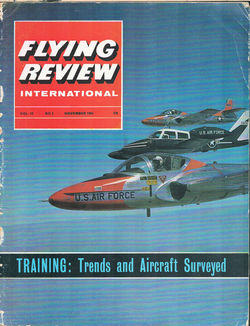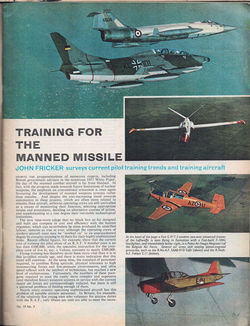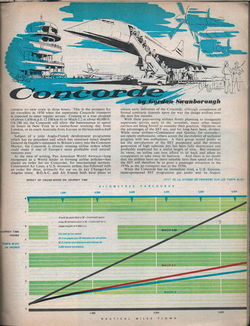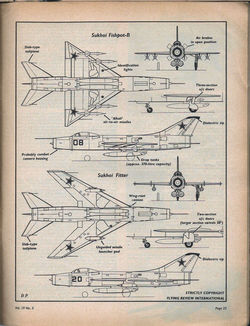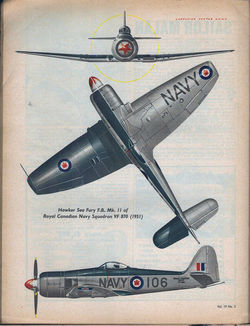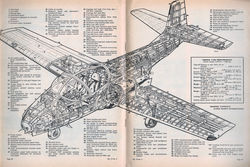FLYING
REVIEW INTL DEC 63 CESSNA T-37 / CONCORDE / HAWKER SEA FURY RCN / JET TRAINERS
NATO & WARSAW PACT
V19 N3
TRAINING AIRCRAFT: TRENDS
SURVEYED
CESSNA T-37 TWEET (USAF,
PAKISTAN AF, PORTUGAL) (INCLUDES THREE VIEW SCALE DRAWINGS & CENTERFOLD
CUTAWAY) - The Cessna T-37 Tweet (designated Model 318 by Cessna) is a small,
economical twin-engined jet trainer type which flew for decades as a primary
trainer for the United States Air Force (USAF) and in the air forces of several
other nations. The T-37C was also capable of light attack. The A-37 Dragonfly
variant served in the light attack role during the Vietnam War and continues to
serve in the air forces of several South American nations. The T-37 served as
the U.S. Air Force's primary pilot training vehicle for over 52 years after its
first flight. After completing initial training in the Tweet, students moved on
to other advanced Air Force, Navy, Marine Corps or Allied trainers. With a
total of 1,269 Cessna T-37s built, the USAF retired its last T-37 in 2009.
NATO TRAINING FOR THE
INTRODUCTION OF THE LOCKHEED F-104 STARFIGHTER (AMI ITALIAN AIR FORCE FIAT
G.91T GINA, BELGIAN AIR FORCE POTEZ FOUGA CM170 MAGISTER, ROYAL NETHERLANDS AF
RNethAF FOKKER S.11, ROYAL NORWEGIAN AF SAAB-91D SAFIR, HUNTING JET PROVOST T.3,
HAWKER HUNTER T.66, CANADAIR CL.41 RCAF
WARSAW PACT TRAINERS (CZECH
L-29, YUGOSLAV SOKO GALEB, MIKOYAN MIG-15UTI)
CONCORDE SUPERSONIC CIVILIAN
COMMERCIAL AIRLINER SST (DESIGN DETAILS, BAC BRITISH AIRCRAFT CORPORATION,
SUD-AVIATION, PRODUCTION PLANNING, OPERATIONS) - The Aérospatiale/BAC Concorde is
a retired Franco-British supersonic airliner jointly developed and manufactured
by Sud Aviation (later Aérospatiale) and the British Aircraft Corporation
(BAC). Studies started in 1954, and France and the UK signed a treaty
establishing the development project on 29 November 1962, as the programme cost
was estimated at £70 million (£1.39 billion in 2021). Construction of the six
prototypes began in February 1965, and the first flight took off from Toulouse
on 2 March 1969. The market was predicted for 350 aircraft, and the
manufacturers received up to 100 option orders from many major airlines. On 9
October 1975, it received its French Certificate of Airworthiness, and from the
UK CAA on 5 December. Concorde is a tailless aircraft design with a narrow
fuselage permitting a 4-abreast seating for 92 to 128 passengers, an ogival
delta wing and a droop nose for landing visibility. It is powered by four
Rolls-Royce/Snecma Olympus 593 turbojets with variable engine intake ramps, and
reheat for take-off and acceleration to supersonic speed. Constructed out of
aluminium, it was the first airliner to have analogue fly-by-wire flight
controls. The airliner could maintain a supercruise up to Mach 2.04 (2,170
km/h; 1,170 kn) at an altitude of 60,000 ft (18.3 km). Delays and cost overruns increased the
programme cost to £1.5–2.1 billion in 1976, (£9–13.2 billion in 2021). Concorde
entered service on 21 January of that year with Air France from Paris-Roissy
and British Airways from London Heathrow. Transatlantic flights were the main
market, to Washington Dulles from 24 May, and to New York JFK from 17 October
1977. Air France and British Airways remained the sole customers with seven
airframes each, for a total production of twenty.
SOVIET AIR FORCE SUKHOI JET FIGHTERS
(FISHPOT & FITTER Su)
RAF HAWKER SIDDELEY FOLLAND GNAT
- The Folland Gnat is a British compact swept-wing subsonic fighter aircraft
that was developed and produced by Folland Aircraft. Envisioned as an
affordable light fighter in contrast to the rising cost and size of typical
combat aircraft, it was procured as a trainer aircraft for the Royal Air Force
(RAF) as well as by export customers, who used the Gnat in both combat and
training capacities. Designed by W. E.
W. Petter, the Gnat has its origins in the preceding private venture Folland
Midge. The issuing of Operational Requirement OR.303 by the British Air
Ministry served to motivate the type's development; the Gnat was later
submitted to meet this requirement. Its design allowed for its construction and
maintenance tasks to be carried out without specialised tools, making it
suitable for use in countries that had not yet become highly
industrialised.[1][2] The Gnat has been viewed as a major motivating factor
towards the issuing of the NATO NBMR-1 requirement, which sought to make
available a common strike/attack light fighter with which to equip the air
forces of the various NATO members. Although
never used as a fighter by the Royal Air Force (RAF), the Gnat T.1 jet trainer
variant was adopted and operated for some time. In the United Kingdom, the Gnat
became well known due to its prominent use as the display aircraft of the RAF's
Red Arrows aerobatic team. The Gnat F.1 was exported to Finland, Yugoslavia and
India. The Indian Air Force became the largest operator and eventually manufactured
the aircraft under licence. Impressed by its performance during combat, India
proceeded to develop the improved HAL Ajeet, a modified variant of the Gnat. In
British service, the Gnat was replaced by the Hawker Siddeley Hawk.
ROTACHUTE ROTABUGGY &
ROTATANK - The Hafner H.8 Rotachute was a British 1940s experimental one-man
rotor kite designed by Raoul Hafner. The
Rotachute was the eventual development of a concept devised by Raoul Hafner, an
Austrian engineer who specialised in rotary wing design, and who had moved to
the UK in 1933 to continue his research and development work. In 1940, he proposed
the use of a single-place strap-on rotor kite in place of a conventional
parachute, to deliver a soldier accurately to a battlefield. The proposal was
made to the Air Ministry in the light of a shortage of silk for parachute
manufacture. Hafner was briefly interned as an alien, but was released to
pursue the feasibility of the idea at the Central Landing Establishment (CLE)
located at RAF Ringway. In October 1940, work began on design and construction
of rotor systems and scale models of rotor kites. The first models were made of
wood and fabric, ballasted to represent a pilot, and had a rotor span of about
3 ft (0.91 m). They were tested successfully by hand launching, but suffered
buffeting and lack of autorotation when launched from aircraft at height. The
third evolution, designated "M.3", had metal rotor blades, and after
further modifications made the first successful launch and descent from a De
Havilland Tiger Moth. Further developments and tests continued into February
1941. The tenth evolution scale model (M.10) had mass-balanced wooden rotors,
ballast of 100 lb (45.3 kg), and a rotor span of 10 ft (3.05 m). On 14 March
1941, the M.10 model was successfully air-launched from a Boulton & Paul
Overstrand.
WW2 RAF BATTLE OF BRITAIN ACE “SAILOR”
MAHAN - Adolph Gysbert Malan, DSO & Bar, DFC & Bar (3 October 1910 – 17
September 1963), better known as Sailor Malan, was a South African fighter
pilot and flying ace in the Royal Air Force (RAF) who led No. 74 Squadron RAF
during the Battle of Britain. He finished his fighter career in 1941 with
twenty-seven destroyed, seven shared destroyed and two unconfirmed, three
probables and sixteen damaged. At the time he was the RAF's leading ace, and
one of the highest scoring pilots to have served wholly with RAF Fighter
Command during the Second World War. After
the war, Malan returned to South Africa. In the 1950s Malan became leader of
the Torch Commando, a liberal anti-authoritarian organization that opposed the
introduction of the apartheid system.
HAWKER SEA FURY (ROYAL CANADIAN
NAVY AIRCRAFT CARRIER FIGHTER) - The Hawker Sea Fury is a British fighter aircraft
designed and manufactured by Hawker Aircraft. It was the last propeller-driven
fighter to serve with the Royal Navy, and one of the fastest production single
reciprocating engine aircraft ever built. Developed during the Second World
War, the Sea Fury entered service two years after the war ended. It proved to
be a popular aircraft with a number of overseas militaries and was used during
the Korean War in the early 1950s, and by the Cuban air force during the 1961
Bay of Pigs Invasion. The Sea Fury's
development was formally initiated in 1943 in response to a wartime requirement
of the Royal Air Force (RAF), with the aircraft initially named Fury. As the
Second World War drew to a close, the RAF cancelled their order for the
aircraft; however, the Royal Navy saw the type as a suitable carrier aircraft
to replace a range of increasingly obsolete or poorly suited aircraft being
operated by the Fleet Air Arm. Development of the Sea Fury proceeded, and the
type began entering operational service in 1947. The Sea Fury has many design similarities to
Hawker's preceding Tempest fighter, having originated from a requirement for a
"Light Tempest Fighter"; both the Sea Fury's wings and fuselage
originate from the Tempest but were significantly modified. The production Sea
Fury was fitted with the powerful Bristol Centaurus engine and armed with four
wing-mounted Hispano V cannons. While originally developed as a pure aerial
fighter aircraft, the definitive Sea Fury FB.11 was a fighter-bomber, the
design having been found suitable for this mission as well. The Sea Fury attracted international orders
as both a carrier and land-based aircraft. It was operated by countries
including Australia, Burma, Canada, Cuba, Egypt, West Germany, Iraq, and
Pakistan. The type acquitted itself well in the Korean War, fighting
effectively even against the MiG-15 jet fighter. Although the Sea Fury was
retired by the majority of its military operators in the late 1950s in favour
of jet-propelled aircraft, a considerable number of aircraft saw subsequent use
in the civil sector, and several remain airworthy in the 21st century as
heritage and racing aircraft. The Royal
Canadian Navy (RCN) became a significant customer of the Sea Fury, and many of
its aircraft were diverted from existing Royal Navy contracts. On 23 June 1948,
the first aircraft was accepted at RCAF Rockcliffe. The type was quickly put to
use replacing Canada's existing inventory of Seafires, taking on the primary
role of fleet air defence operating from the aircraft carrier HMCS Magnificent.
Two Canadian squadrons operated the Sea Fury, Nos. 803 and 883 Squadrons, which
were later renumbered as 870 and 871. Pilot training on the Sea Fury was
normally conducted at the RCN's HMCS Shearwater land base. Landing difficulties
with the Sea Fury were experienced following the RCN's decision to convert to
the U.S. Navy's deck landing procedures, which were prone to overstressing and
damaging the airframes, as the Sea Fury had been designed for a tail-down
landing attitude.[53] The Sea Fury would be operated between 1948 and 1956 by
the RCN, whereupon they were replaced by the jet-powered McDonnell F2H Banshee.
The retired aircraft were put into storage, and some were subsequently
purchased by civilians.
REPUBLIC P-47 THUNDERBOLT COLOR
PROFILES WW2 USAAF FG RAF DOMINICAN MILITARY AVIATION CORPS



